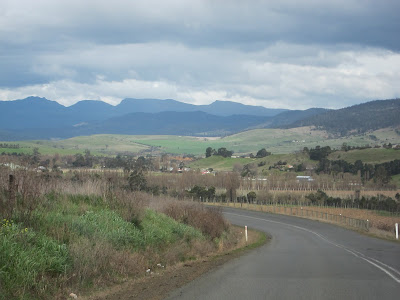Tasmanian Devil Conservation Park
The Warner Bros character Taz is part of our childhood memories so we were thrilled to meet real Tasmanian devils!! And surprisingly they are really cute little animals, smaller than a dog. Their unfair name ("devil") probably comes from their cry. But they are relatively harmless animals: not very agile, bad runners and jumpers. Only their jaws are very powerful. This carnivorous marsupial ends up eating mostly animals already dead or injured or stupid enough to get caught.
******
Tasmania is an heart-shaped island located southeast of Australia. The weather is more temperate than the rest of Australia, creating a very diverse and rich environment. About one third of Tasmania is protected as National Park and one fifth is world heritage listed. A large part of the territory is also cultivated or used as pasture for numerous cows and the famous merinos sheeps! Few towns punctuate the territory but the island is not very populated with only 500.000 inhabitans for 68.000km2 (more or less the size of Ireland). This wonderful situation makes Tasmania one of the place on earth with the cleanest air.
Lake Pedder
Pirates Bay
The best way to visit the island is of course by car, to admire the variety of vistas and make a lot of pictures stop. In fact it is the first time it has been so challenging to choose less than twenty pictures between the four hundred we took during our six days in Tasmania! Landscapes alternate from moutains to huge lake, bucolic hilly countryside, cliff and sandbeach coast or rainforests with very high trees. Some of them are up to 10.000 years old.
******
Richmond was once the most populated area of Tasmania, filled with farmers and convicts coming from Britain, at the time when Tasmania was still called Van Diemen's Land after the Dutch governor of the East Indies. The houses have been well preserved and the surrounding environment seems intact. This creates a really lovely historic village:
Richmond bridge (oldest bridge in Australia) built in 1823 and
St John Church (Australia's oldest existing Catholic church) built in 1826
******
The astonishing view of Hobart from Mont Wellington
Hobart is the second oldest city of Australia, located some ten kilometres from where the British settlers originally punged their anchor on the island. It is now the biggest city and harbour of Tasmania and the capital of the state. The city centre appears provincial, quiet and picturesque with still some buildings built by convicts. Salamanca market every Saturday morning is a local institution to taste food specialties and admire the craft skills of this territory.
Sullivans Cove
Salamanca Market
Salamanca Market
We couchsurfed for three nights in Hobart and happened to learn some local colorful expressions. For example "park a tiger" means "to throw up" or "full as the last bus home" means "very drunk".
******
A new museum was opened in January 2011, a few kilometres north from Hobart. The ride in ferry from Hobart habour to the museum is really idyllic! The Museum of New and Ancient Art (MONA) hosts David Walsh's private collection of ancient, modern and contemporary art. Both its creator and some works exposed are very controversial. The poop machine (Cloaca professional by Wim Delvoye) for instance has been much commented. Modernity is a key word there. For example there are no titles under the pieces but you visit the museum holding an iPod which displays information about the works near you.
Cloaca professional
Us playing with an interactive screen


















































